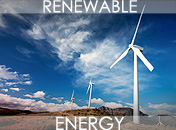
Once constructed, many renewable energy plants do not require “fuel” to run at all in the traditional sense, only maintenance. However, the benefits of alternative energy come with alternative cost considerations. In addition, the field of renewable energy is currently undergoing rapid change in terms of both technological advances and falling prices. This leads to two questions:
- What are the comprehensive, or “true,” costs of the various types of renewable energy?
- How do these costs compare with the costs of traditional energy resources?
Renewable energy is in a dynamic phase in its development, with new technologies being introduced, old ones refined, prices in flux, policies in motion, and investors and utilities trying to make the best investments in the future of energy resources. If efforts to develop energy storage technologies mature, they could greatly affect the ability of resources such as solar and wind to provide energy to society on demand. Until then, each energy resource has a set of costs and benefits that dictate the role it can play in the energy portfolios of power companies, states and the country. Intermittent renewables such as wind and sun serve best as a complement to existing peak demand and base load generation resources, such as coal and gas. Geothermal, biomass and hydro, on the other hand, can supplement the base load capacity of coal- and gas-fired plants. So the question of which resources are best to use in a given place is not so much one of “either renewables or fossil fuels” as it is “what combination of resources is best, given local and regional circumstances.”

